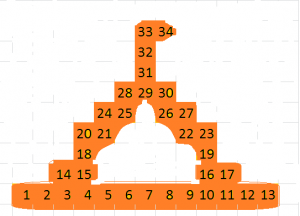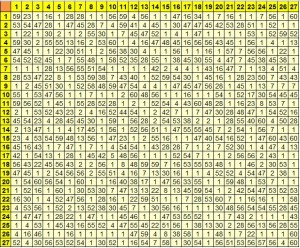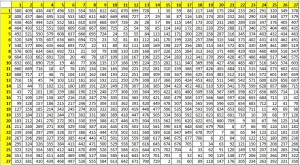It is my very humble endeavor to apprehend the great creativity of Muni Kumudendu who crafted a unique marvel about thousand years ago in Karnataka. This inimitable creation of Muni Kumudendu, which is designated as a unique treasure house of knowledge is known as ‘Siri Bhoovalaya’. ‘Siri Bhoovalaya’ is a distinctive piece of literature which is scripted in numerals. Integers (of values 1 to 64) are arranged in 1270 Chakras where each Chakra is a matrix of 27×27 Integers. Each of the Integers is associated or encoded with a phonetic character primarily of origin in Kannada. Deciphering of sequences of numerals of a Chakra in specific manner reveals poetry and verses in different languages. In addition to Kannada, the languages in which the Chakras manifest poetry and verses include Prakrita, Samskrit, Telugu, Tamil, Apabhramsha and Pali etc. totaling 718 of dialects. The subject matters covers religious scriptures of Jains, Vedas, Ayurveda, Astrology and Mathematics too. Most of this work has not come to light due to difficulty in deciphering the schemes in respective Chakras.
Muni Kumudendu was a Jain saint in lineage of Deshi Gana / Nandi Sangh. Under strange circumstances only remaining copy of the original manuscript of unique epic ‘Siri Bhoovalaya’ was brought to light by Pandit Yellapa Shastri through his tireless efforts in around 1950’s. Till that time this spectacular and only such creation in human history remained undiscovered. Since the whole script was in numerals and that too enciphered in variety of schemes, the work did not attract attention of even great scholars. Pandit Yellapa Shashtri deserves countless thanks for bringing this gem of originality to be recognized and appreciated by concerned persons.
Siri Bhoovalaya has primarily a Kannada base, but has been claimed to contain verses and poetry of 18 major languages and 700 minor ones. The whole volume consists of 1270 Chakras. Each Chakra is matrix of 27×27 integers. Each integer has value in range from 1 to 64 only. Each integer is associated with a Character (Kannada) and which has a corresponding phonetic value as well. In order to decipher a Chakra a scheme of traversing the matrix is specified, which is called a ‘Bandha’. Many of Bandhas have been specified by Muni Kumudendu but many more yet remain to be discovered.
ChakraOne Chakra is arrangement of numbers (in range 1 to 64) in a matrix of 27 rows and 27 columns. There are 1270 Chakras available and are classified into 56 Chapters. It is estimated that sum all the Chakras contain 600000 Shlokas which is equivalent to 1400000 letters.
Following figure portrays the first Chakra of SiriBhoovalaya.
Number to Phonetic Alphabet Substitution Table in DevnagariFollowing Table is used to substitute Numerals in all the Chakras into Phonetic Aplhabets. Some of the Phonetic Alphabets don’t find usage in contemporary scenario and in specific languages as well.
Bandha:A Bandha is manner in which contents from a Chakra is revealed. Bandha basically describes the method to traverse the 27×27 matrix and substitute respective numbers into letters to uncover the Shlokas or verses hidden therein the Chakra. There are many Bandhas which are identified as Chakra-Bandha, Navmaank-Bandh, Shreni-Bandha, Hans-Bandha, Anu-Bandha, Mayur-Bandha, Saras-Bandha, Padma-Bandha etc. etc.
To decipher a Chakra-Bandha the 27×27 Matrix of the Chakra, all cells are traversed in the sequence as illustrated in the figure starting from cell designated as 1 to 729. Cell 1 is located at Row-1 and Column-14, Cell 2 is located at Row-27 Column-15 and so on until last Cell 729 at Row-27 Column-14 is traversed. Substitution of Integers in respective Cells with corresponding alphabets results in plaintext in Kannada composed in ‘Sangatya Chhanda’.
Following screen-shot demonstrates deciphering of first Chakra using Chakra-Bandha Scheme as described above.
Resultant text after conjoining above phonetic alphabets:
अष्ट महाप्रातिहार्य वयभवदिन्द । अष्ट गुणन्गलौल औम्दम । स्रष्टिगे मंगल पर्याय दिनित | अष्टम जिनगेरगुवेनु टवणेय कौलु पुस्तक पिन्छ पात्रेय । अवत्रदा क…
Chitra-Bandha / Chitra KavyaChitra-Bandhas are named after the graphical figure (Chitra) they are associated with. In Chitra-Bandha a particular graphical figure or Chitra (with its cells numbered in sequential order starting from 1) is superimposed on a specified Chakra at defined position (row and column) to reveal content in those particular superimposed cells on the Chakra in the manner as shown in following EXAMPLE.

Chitra-Bandh’s Graphical Figure or Chitra.
In following picture the Chitra-Bandha figure is superimposed on the specified Chakra (Example Chakra)
After appending string of numbers from the Superimposed Chakra’s cells in the same order as marked on the Chitra-Bandha and then applying Phonetic Alphbet Substitution we get result as shown in the table bel
| 52 | 7 | 47 | 4 | 28 | 7 | 52 | 7 | 45 | 16 | 47 | 45 | 7 | 30 | 7 | 54 | 7 | 62 | 28 | 10 | 43 | 1 | 59 | 4 | 54 | 4 | 51 | 8 | 56 | 1 | 55 | 1 | 53 | 1 |
| म् | उ | न् | इ | क् | उ | म् | उ | द् | ए | न् | द् | उ | ग् | उ | र् | उ | : | क् | ऋ | त् | अ | स् | इ | र् | इ | भ् | ऊ | व् | अ | ल् | अ | य् | अ |
On adjoining conforming phonetic alphabets following text results:
मुनि कुमुदेन्दु गुरु: कृत सिरि भूवलय
Note:A Computer Program for deciphering Chakra-Bandh is available with the author of this page. If you are interested in using the same, please leave your comments in this regards here. A Computer Program for Navmaank-Bandh is also available to intersted persons. Computer Program development is in progress for deciphering Chitra-Kavya-Bandhas.
You are welcome, If you want to share your own experience in understanding various Bandhas, corresponding algorithms and Computerisation at any level. Your contribution will be published on this web-site.




